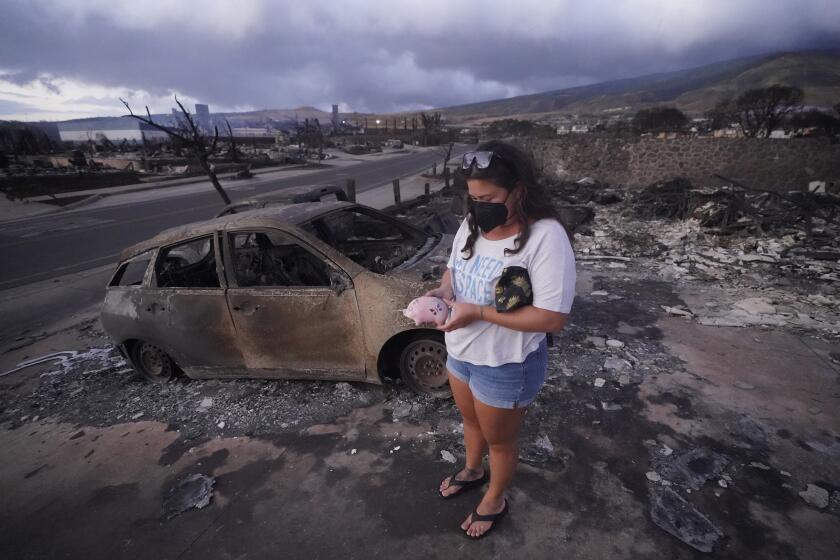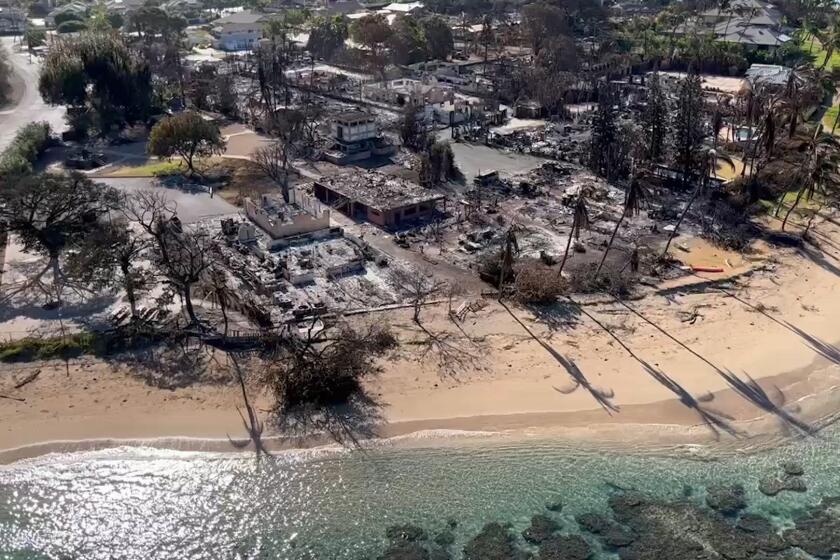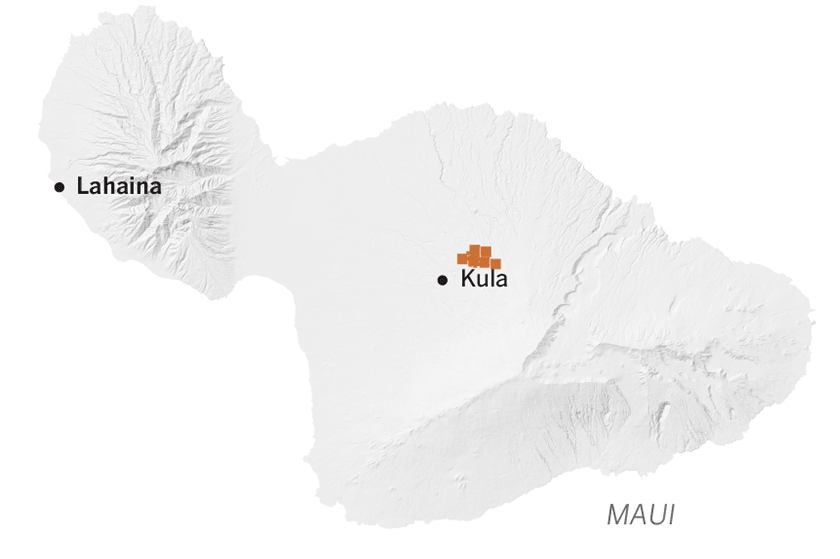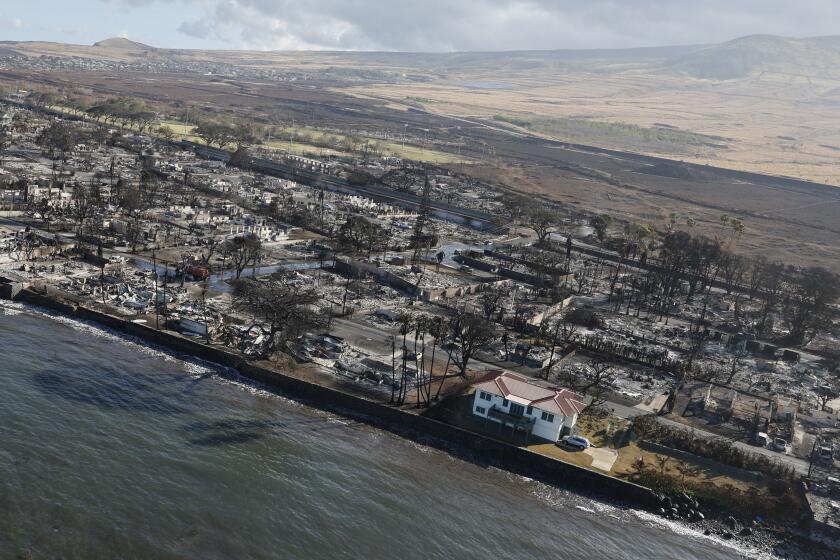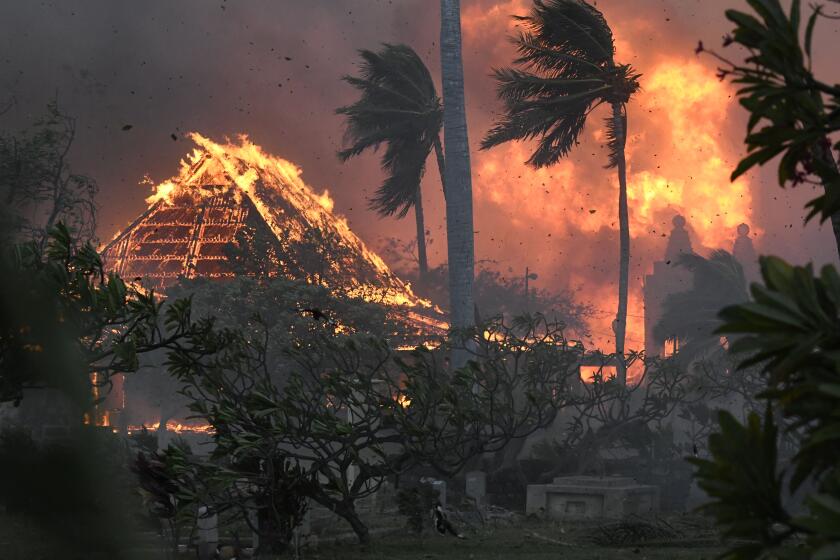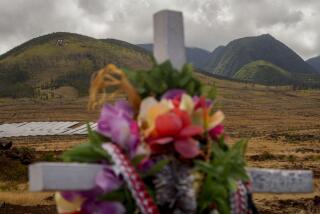Fateful decision in Maui: Firefighters left the scene, blaze began its deadly march unchallenged
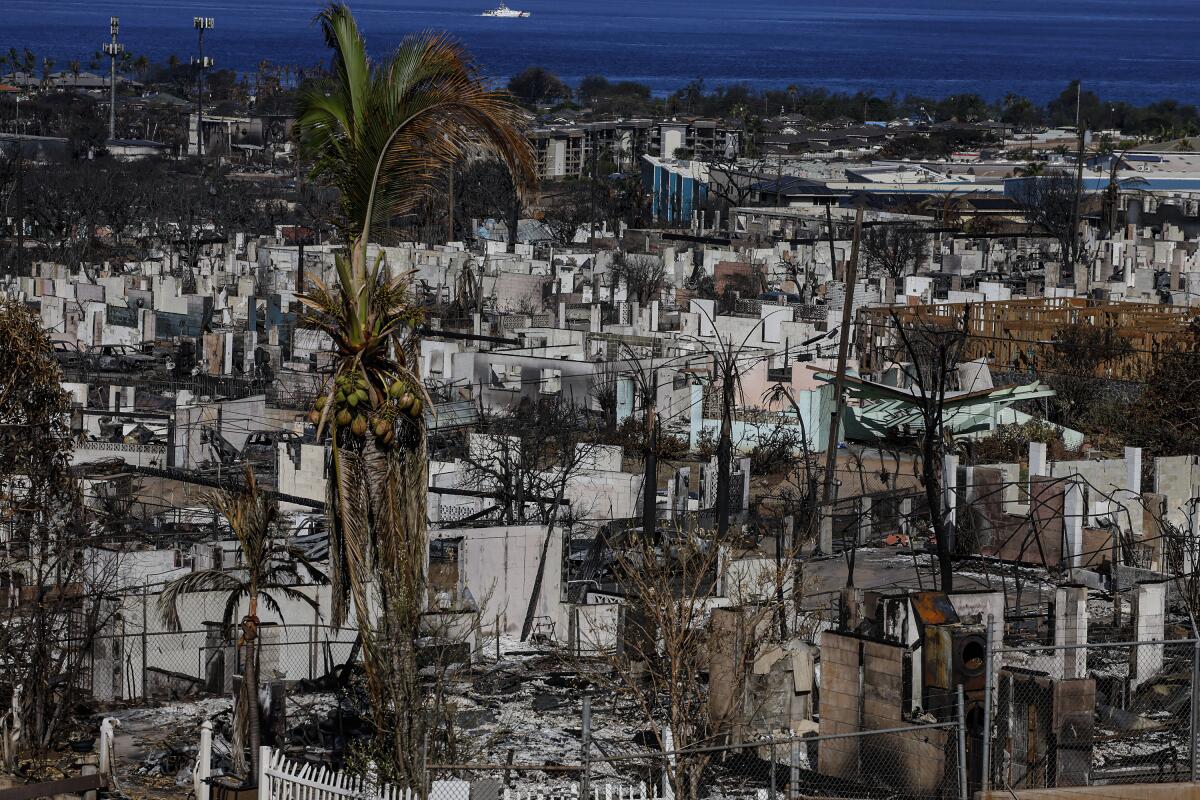
- Share via
LAHAINA, Hawaii — In the first hours of what would become the Maui firestorm, firefighters had a fateful choice.
After responding to an initial small fire on the edge of town shortly after sunrise, officials determined that it had been fully contained and the danger to the historic town of Lahaina had passed.
With other fires burning elsewhere on the island, emergency personnel made the decision to move on. But within an hour or two of the last firefighters leaving the scene, the blaze began to flare up, according to witnesses.
With no defense, and fueled by forecasted intense winds from the northeast, the fire became a monster, targeting a town that had stood for centuries. In a short span of time, it burned all the way to the ocean, ultimately reducing much of Lahaina to ash and leaving entire families — including the elderly and children — trapped in cars or homes. Officials warned that the bones of some of the dead are so charred that their remains may never be recovered.
It probably will take months for authorities to conduct a full review of the decisions made on the day of the fire, as well as past preparedness efforts. Still, the move to pull fire crews from the blaze shortly before it began its deadly spread has become a flashpoint as questions mount over whether government institutions could have done more to stave off the massive losses of property and lives.
Officials long knew of the risk of a major blaze, but a review of records and interviews shows there was not a fire evacuation plan for Lahaina.
Among the best practices in fighting wildfires is the “mop-up,” the difficult task of extinguishing burning materials all the way down to the mineral soil and cooling ash pits, which can take several days after a fire is considered “contained.”
“Mop-up is difficult, dirty and lacks the excitement of initial attack and direct suppression; however, it is a critical phase in the suppression process because remaining burning debris may rekindle,” a training manual for the National Wildfire Coordinating Group says. “Mop-up must be thorough because a small spark or flame could rekindle, starting another and perhaps larger fire.”
It’s a lesson that should have been learned from past fires — notably, the Oakland-Berkeley Hills fire of 1991, which caused 25 deaths. In that fire, California’s third-deadliest in modern history, firefighters thought the blaze was under control and left for periods of time overnight. They returned the next morning and were dealing with hot spots when it flared up amid extreme fire weather, becoming an uncontrollable, wind-driven urban conflagration that destroyed more than 3,300 homes and resulted in chaotic evacuations.
The response of Maui firefighters is one of several areas of scrutiny. Island officials had been warned about the high fire risk to Lahaina but did little to address it. And Hawaiian Electric, the utility company, had no plan to cut off electricity ahead of the extreme fire weather, reducing the risk of sparking power lines, which is a standard procedure in California.
“This could have been avoided if it was guarded. That’s all I’m saying,” said Lahaina resident Juan Advincula.
A Maui tourist hub looks like a wasteland, with homes and entire blocks reduced to ashes in one of the deadliest U.S. blazes in recent years.
The initial Lahaina wildfire was reported Aug. 8. at 6:37 a.m.
One of the first people to spot the fire was Advincula’s wife, Dominga. She was preparing to leave for work about 6:30 when she heard a thundering boom: a transformer on the hillside near her home on the northeastern edge of town appeared to have blown.
She said she saw what looked “like stars” — an electrical line sparking, igniting dry grasses. The power line was across from Lahaina Intermediate School, just beyond the cul-de-sacs at Kuialua and Hookahua streets. That area had once been used for sugarcane farming, according to state records, and was now fallow fields.
She ran back in the house and called 911, then called her manager at the Westin resort in Kaanapali to say, “I’m not coming to work because there’s fire in front of my house,” she said.
The sparking came amid dangerous fire weather that had been forecast for several days. The previous day, the National Weather Service issued a red flag warning, alerting the public of dangerous fire conditions, including wind gusts as high as 65 mph and very dry humidity.
Dominga and eight family members initially fled to a cousin’s house down the hill near the center of Lahaina. Officials said the brush fire was 100% contained by 9 a.m., and the Advinculas returned home around 10 a.m., after seeing the smoke clear.
The Lahaina fire in West Maui ignited as firefighters focused on the Upcountry fire. What happened next — the deadliest U.S. wildfire in more than a century — left the historic town in ashes.
By early afternoon, the winds were still raging, Juan said. But between 1 and 2 p.m., the few firetrucks that had remained on the hillside left, both Advinculas said.
“Why are they going?” Juan remembered asking his wife, as he looked out the oversize windows in his family’s second-story living room. “They need to watch the embers and stuff. Hopefully it doesn’t fly off.”
Less than two hours after the firefighters left, the couple’s fears had come to fruition.
A small cloud of smoke was visible at the edge of their cul-de-sac. Then the fire “spread like water” through the tall, dry brush near their home, Dominga said.
A neighbor who works with Dominga called 911, while she and her family scrambled to get out of the house for the second time that day.
“We didn’t even take anything ... just ourselves, our dog, my thoughts,” she said, describing how the family returned to the same relative’s house.
A red-roofed house appears untouched amid the devastation of the Lahaina fire. Its owner says recent renovations may have helped make it fireproof.
But 15 minutes after arriving at that refuge — less than a mile downhill — the Advinculas’ son said, “ ‘Mom, we have to leave this house. It’s getting hot,’ ” Dominga said.
“Coming up from that street — Paunau — to Front Street, it’s a dead stop — like trees falling on the cars, black. Like apocalypse. It was hard to get out,” she said, describing their evacuation route.
Electric wires and poles were hanging down. A police officer directed the Advinculas’ 23-year-old son, who was traveling in a separate car, to exit to the south while his parents headed north and took shelter at the Royal Lahaina Resort, where Juan works as a food runner.
It would be 24 hours before the couple were able to reach their son and know he was safe after having spent the night with a friend in Wailuku.
The Advinculas’ own home — as well as an entire subdivision north of the fire and therefore not downwind from the blaze — were spared from destruction. But hundreds of other houses in the heart of historic Lahaina and its waterfront were suddenly in the path of the fast-moving, ember-studded winds.
Human searchers have little chance of detecting the tiny fragments that remain of wildfire victims in the ashes of Lahaina. Hope rests with trained cadaver dogs.
Another witness also noticed the lack of firefighters at the scene of the initial blaze. Relyn Delfin was heading home after an early-afternoon close of the souvenir shop ABC Stores on Front Street in Lahaina. The power had gone out, and the weather was bad, with ferocious winds violently shaking trees and clattering the store’s glass doors.
The last customer had come in just before 1:30 p.m., before the decision to shutter the store for the day, Delfin said.
To travel home to Waikapu, in central Maui, she drove uphill in her Honda Accord along Lahainaluna Road — perpendicular to the coast — to get to Lahaina Bypass, a highway above town that would allow her to take another route south, avoiding a closure where police were already blocking other streets where trees and electrical lines had been pulled down by the winds.
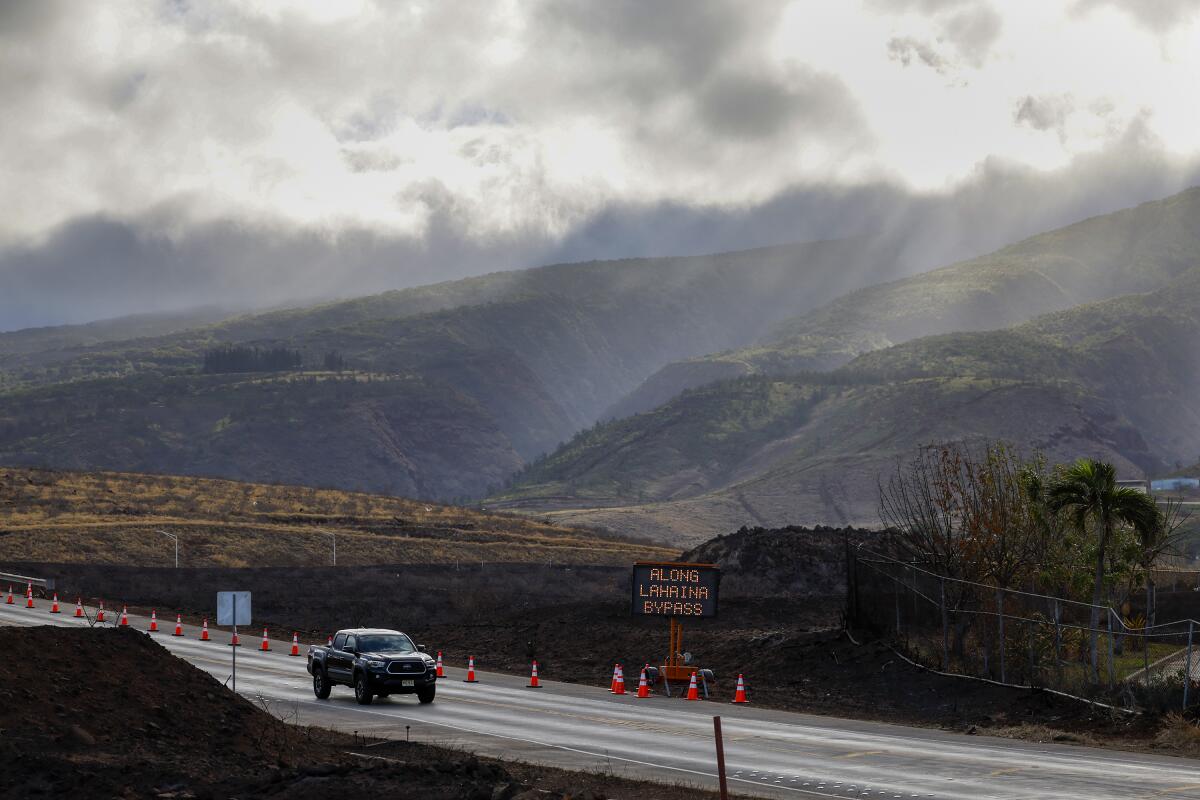
Delfin listened to the howl of the wind as she drove near the Advinculas’ home. She looked up and saw the same thing the Advinculas had noticed: No one.
“That’s where the first fire in the morning was,” she said of the spot, which had not yet reignited. “I passed and there is no firetruck at all.”
The departure of the firefighters from the initial Lahaina fire, reported by other news organizations including the Associated Press and the San Francisco Chronicle, was spurred by the need to fight fires elsewhere on Maui, Hawaii Gov. Josh Green said in an interview with CBS.
By 3:30 p.m., witnesses in other parts of town noticed thickening smoke. Around the same time, Lahaina Bypass was closed after “an apparent flareup of the Lahaina fire,” Maui County officials said in a statement. An hour later, homes were burning. And by 5:45 p.m., the Coast Guard was receiving reports of people who had fled the fire by running into the ocean and now needed rescue.
The Hawaiian Islands do see wildfire from time to time, but the catastrophic Maui fires were spawned by a striking mix of factors, including climate change.
Wildfire experts and emergency response managers agree that keeping watch over a contained fire, including mop-up efforts, is important. Michael Guerin, a former assistant director for response and recovery for the California Governor’s Office of Emergency Services, said it’s typical to “see a number of firefighter engines or other vehicles there all night for several days, sometimes” watching over a contained fire. “You stay not just until it looks like it’s out, but you’ve had a day or two of it looking like it’s out.”
Given the fire weather conditions in effect the day of the Maui blaze, it’s likely that investigators will examine whether officials should have ordered widespread evacuations in Lahaina that morning. With downslope wind and low humidity predictions, there were indications the entire town would be threatened if the initial fire got out of control.
Reports reviewing the Oakland-Berkeley Hills fire and other blazes note that little can be done to rein in a Santa Ana-type wind-driven wildfire after ignition.
“When the Santa Ana (or Diablo) wind is blowing, and a fire occurs in a susceptible area, there is very little that any current fire-suppression forces or technologies can do to resist the spread of the fire,” according to a U.S. Fire Administration report on the 1991 fire. “The results will depend mainly on the fuel that is downwind from the fire and the length of time that the wind continues to push the fire in that direction.”
It’s also apparent that an earlier evacuation order could’ve saved more lives.
Over a week after fire incinerated Lahaina, locals are pressing for a return to work as they seek some sense of normalcy.
A simulation of evacuating all of Lahaina suggests it would take a minimum of three to four hours to empty the city by sending evacuees south on the main exit out of town, said R. Michael Robinson, chief operations officer of the Virginia Modeling, Analysis and Simulation Center at Old Dominion University, which developed the model known as the Fast Local Emergency Evacuation Times.
Advincula said he suspects that had the firefighters stayed at the scene of early morning fire, the day would not have turned so tragic.
The Advinculas’ cousin Antonia “Toni” Molina was missing for two weeks after the fire, until officials added her name to the list of the dead. The 64-year-old’s remains were found inside the ashes of the family home on Paunau Street, where the Advinculas twice sought sanctuary from the flames, they said.
“I’m the first one to say they were doing a good job — until they left the place unattended,” he said of the firefighters. “Then that’s when everything went kaput.”
Wick reported from Lahaina and Lin from San Francisco.
More to Read
Sign up for Essential California
The most important California stories and recommendations in your inbox every morning.
You may occasionally receive promotional content from the Los Angeles Times.
